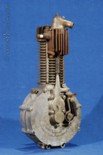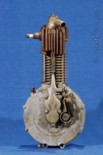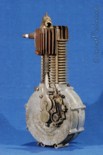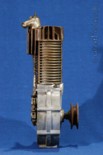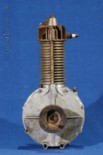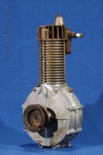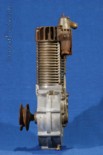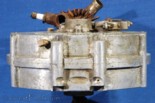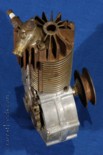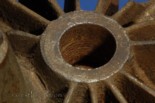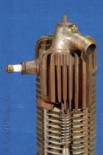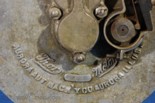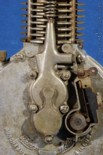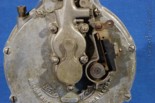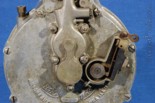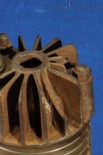Exceedingly Rare 1904 Hedstrõm Motor, First Motor to Power an Indian Motorcycle. Sold!
Patents, click on any image to see larger image!


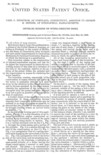
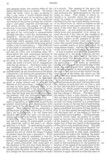
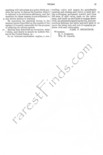
What I’m offering here is not only an exceedingly early and rare internal combustion engine designed by famous 19th century bicycle racer, inventor, and motor bicycle racer Oscar Hedstrõm, it is also an important piece of American History.
Hedstrõm’s motor or engine powered the first Indian motorcycles which were called motor-bicycles. The design was a so called air cooled four stroke “inlet over exhaust” type; both valves are operated by the same push rod. The displacement of his first design was 213cc, producing 1-3/4HP. The motor had a provision on top of the cylinder head, a threaded hole, so the engine could be mounted as substitute of the seat-post and be an integral part of the bicycle frame to save weight, see picture 10.
Initially manufactured by the Aurora Automatic Machining Co., the Thor motor was also called “Oscar Hedstrom engine.”
Though of specific Indian design, and related to the 1900 patented engine design of Emil Hafelfinger of New Jersey — a derivative of the French De Dion-Bouton design — engines were produced by Aurora Automatic Machinery Company of Aurora, Illinois. Strong bicycle-style diamond frames were made in a small shop in Springfield, Massachusetts, to be fitted with the Hedstrõm motor.
Hedstrõm completed his first prototype on May 25, 1901, at the old Worcester Cycle Manufacturing Company in Middletown, Connecticut, and the first public demonstration was held on Cross Street in Springfield, Massachusetts, at 12:00 noon on Saturday June 1, 1901.
According to history, only 137 Thor motors were produced in 1902. It is fair to assume that production was increased from the 137 produced in the first year in the following years.
The antique motor here bears the serial number A624 which is stamped into the motor (see picture 12) and was made in 1904.
The following writing is cast into the cast aluminum motor-housing, “Thor Motor, AURORA AUT MACH”Y CO AURORA ILLINOIS.”
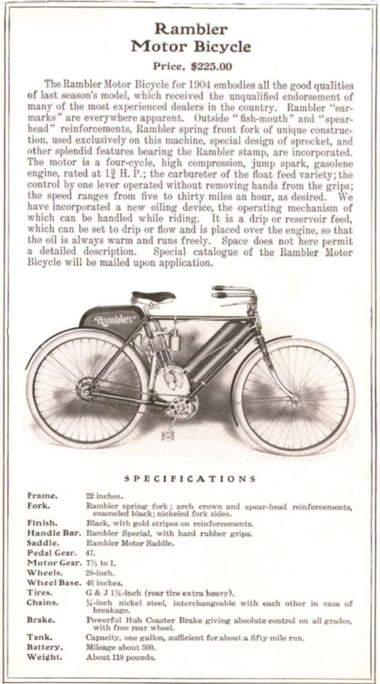
A 1904 Rambler with motor serial number A590 stemming from the EJ Collection was sold by MECUM Auctions in Las Vegas on March 20-21, 2015, as lot F50 for $30,000 (excluding buyer’s premium) with an estimate of $50,000 to $75,000.
The same Rambler motor bicycle model 1904, with the same serial number A590 sold as lot S9 at MECUM’s Auction again two years later in Monterey CA, for $35,000.00, not including buyer’s premium and sales tax.
The serial numbers A590 and A624 are only 34 motors apart and it is fair to assume that they both were manufactured in the same year, the year 1904.
MECUM sold a 1905 Indian Camelback in Las Vegas in 2019. This one had serial number 1,917 and sld for $104,500. This restored motor-bicycle was part of the MC collection of Stockholm.
A 1904 Thor with unknown serial number stemming from the Bill Harrah collection did not meet reserve when it was offered by MECUM Auctions in Las Vegas on April 30, 2021. This 1904 Thor was lot F192 and the reserve was set at $50,000 (excluding buyer’s premium).
The last early Indian Camelback with a Hedstrom motor was sold at auction between September 6 - 9, 2023, as lot S156 in Anamosa, Iowa, at the National Motorcycle Museum, conducted by Mecum Auctions. This Indian Camelback, a 1903 model with the serial number 358, was part of the collection of the John & Jill Parham Estate, and sold for $57,200 plus buyers premium.
By 1908, serial numbers were up to 11,430 (lot F151, MECUM auction 2019 in Las Vegas).
Under the contract between Hedstrom and Aurora, Aurora was allowed to manufacture as many motors as they could sell to other establishments which built motorized bicycles after supplying as many motors first, needed by Hedstrom and Hendee for the Hendee Manufacturing Co. Under the agreement, Aurora would pay royalties to Hendee Mfg. Co., for every motor sold to other motor-bicycle manufacturers.
Rambler was a brand name of Pope Mfg. Co., which organized the American Cycle Mfg. Co., especially for motor bicycle production in 1902; Pope also had manufacturing plants in Hartford and later in Springfield Massachusetts. The Rambler model 1904 which was a clone of the Indian Camelback was priced at $225.00 in 1904, see picture on the right.
Oscar Hedstrom set a speed-record with his Thor motor manufactured by Aurora in 1903 of 56mph; these motorized racing bicycles had no clutch or brakes and many accidents ended up killing the race-drivers.
In 1905, Hendee Manufacturing Co. in Springfield reportedly produced 1,000 motor-bicycles which they sold under the brand name “Indian.”
Hedstrom did not change the design of his motor between 1903 and 1905; In a 1908 parts catalog Aurora shows a picture of the original 1903 design and called it a 1903-05. Models for the years 1906-07 were based on the same design but had numerous changes. The design was updated in 1908 and sold as model “7”. In 1911, Thor engines were offered with a clutch for the first time. Rocker arms changed the design in 1912 in a radical way.
Back in 1904 however, they called them “motorized bicycles” and not “motorcycles,” the term motorcycles was not born yet! The company was called Hendee Mfg.Co., and the motor-cycles were sold under the model or brand name “Indian.”. Only in 1923 the name was changed to Indian Motocycle Mfg. Co., but more under “History” further down.
Picture on the left; Oscar Hedstrom with a “Camelback” Indian motor bicycle.
Condition:
This super rare motor or engine with serial number A604 is in good condition, everything moves smooth as it should (I sprayed some oil into the cylinder before I cranked the shaft). The little cover over the timing mechanism is missing. Other than that, this motor is complete. There is no carburetor. There are no cracks. Three of the cooling fins are damaged as shown in pictures 4, 5, 6, and 16. I have not dismantled the motor but I expect there are no surprises inside.
Somebody attached a pulley to power something, a washing machine?
If a potential buyer is interested to see the internal parts, I will take it apart and make pictures for $100 down-payment. If there are any surprises I will refund the $100. I have the necessary tools and experience to take it apart and to put it back together. The $100 payment is to protect me from requests from individuals who do not seriously intend to buy it.
History:
The top bicycle racers of the third quarter of the 19th century were the super stars of their time, like the Football and Basketball stars of today.
There were no paved roads back then and races were held on oval circuits made of wooden boards, or along sandy ocean beaches. Madison Square Garden was one of many places were board track racing events were held on weekends, but the first races were held near Daytona Beach, FL, as early as March of 1903.
With the dawn of the 20 century, the internal combustion engine entered first the bicycle race scene as a wind breaker or pacer, and shortly after — not surprising — also as power source of motorized-bicycles which raced against each other.
Like the racing bicycles, these motorized bicycles had no brakes; these motorized racing bicycles also had no clutch and achieved speeds of up to 56 mph (Hedstrom record set in 1903 with his own motor-design).
The following write-up focuses on the famous names, events, and places surrounding the Thor-motor offered for sale here, such as Carl Oscar Hedstrom, George Mallory Hendee, the Hendee & Nelson Manufacturing Company, the Hendee Manufacturing Company, the Indian Motocycle Manufacturing Co., the Aurora Automatic Machine Co., and
“Murderdromes”
Carl Oscar Hedstrom:
Carl Oscar Hedstrom, born March 12, 1871, in Sweden, died on August 29, 1960. He was a very successful bicycle racer, a super star at the time. Hedstrom grew up in Brooklyn and became a machinist and tool maker working in New York City. He first became an amateur and later professional bicycle racer. At his Brooklyn bicycle shop, Hedstrom built high-quality custom bicycles for racers that were lighter and more durable than standard bikes. Hedstrom's racing bicycles were highly sought after and earned him quite a reputation.
In February 1898, he rented space which came with tools and machiniery from the Worcester Cycle Mfg. Co., located in Middletown, Connecticut. At the time he was 27 years of age and still racing.
During a six day event at the Madison Square Garden in Manhattan on December 3, 1898, Hedstrom saw for the first time a pacer tandem equipped with a motor.
Bicycle racers had tandem pacer teams to split the wind during races. Depending on the distance of a race, a bicycle racer needed up to a dozen pacer teams per race. This was costly. Up to this day, these pacer teams pedaled their tandems; there were no motors before.
A motor invented by a French named Compte DeDion in 1896, and manufactured by DeDion-Bouton et Cie., at Putaux, France, found its way to the Americas. This motor was about to change not only how bicycle racers were paced. With a motorized pacer only two drivers were needed; one driving the tandem, the other fine-tuning the motor and keeping it running at the right speed. Financially this was a huge savings and had other advantages as well.
The first official bicycle race in the U.S. using a motorized pacer took place at the Waltham, Massachusetts, racetrack in November 1898.
These motorized pacers powered by the DeDion motor functioned poorly and proved to be unreliable. On December 26th 1898, a 20-mile race was held at Madison Square Garden. A French racer, Amedee Furnier, was paced by a DeDion powered pacer tandem, while an American racer, Harry Elkes, was paced by seven tandem teams. It was a showdown between men and machine.
After three miles, the drive belt on the DeDion powered pacer broke and Furnier lost the race. For once, men triumphed over machine. The incident was described in [1], page 167 as follows:
The crowd was properly dazzled as Fournier’s “fastest two-wheeled vehicle ever built” took up its warming run around the track. Unfortunately, some of that dazzle dulled appreciably when the machine broke its leather drive belt after only three miles. To add insult to injury, Fournier could not disengage the engine and the machine lay on its side, its motor running until the fuel ran out, dying like some mechanical beast. The race was touted as a win for humans over machines although Fournier’s pit crew alleged someone tampered with the machine. Nevertheless, either event probably offered enough of a demonstration for Hedstrom to become smitten by the motor machine and convinced that his mechanical talents could improve on its performance.Oscar Hedstrom was present that day, and competed in the professional half-mile race (placing 1st) and the one-mile handicap (placing 2nd): it’s hard to imagine that he missed seeing the DeDion powered pacer perform, or the lack thereof.
In May of 1899, Hedstrom, Henshaw and Fournier, together with almost every top racer in the country were indefinitely suspended by the League of American Wheelmen (“L.A.W.”) Racing Board for participating in unsanctioned races.
This suspension provided Hedstrom an opportunity to put his attention towards improving the French DeDion motor powered tandem pacer. Another source claims that Hedstrom crashed with two other racers and dislocated his shoulder during a race on June 19th at the Manhattan Beach in the fourth lap of the Great Atlantic Sweepstakes. It was this injury which allegedly forced him to take a break for the rest of the season.
To improve the DeDion tandem, he partnered with Willliam Russel Frisbee, the Bridgeport, Connecticut Pie Company founder and inventor of the flying pie plate renamed the Frisbee. Frisbie worked for the Worcester Cycle Company as a draughtsman until the fall of 1897, which was aboput two years ealier. The partnership was unveiled in the local press on September 18, 1899:
R. A. Frisbee and Oscar Hedstrom are engaged in building a motor wheel which it is believed will eclipse anything yet placed on the market. It is probable that they will also furnish a motor for the wheel of their own designs. The drawings of the wheel which have been shown to some of the professional riders have elicited much praise and already two vehicles have been ordered after the pattern.
On November 18th 1899, the local press reported that “Frisbee and Hedstrom” had built a new “infernal machine”.
The wheel resembles in many ways the infernal machine exhibited by Fournier, the Frenchman, at Crystal Lake Park last June but is more modern. The wheel is enameled a royal blue and presents a handsome appearance. The nameplate will bear the name Hedstrom.
Hedstrom’s first motor tandem was tested on Friday, November 24, 1899, on the streets of Middletown, Connecticut. Hedstrom’s first motor tandem was actually built under a contract arrangement with Chicago racing star Charles Miller.
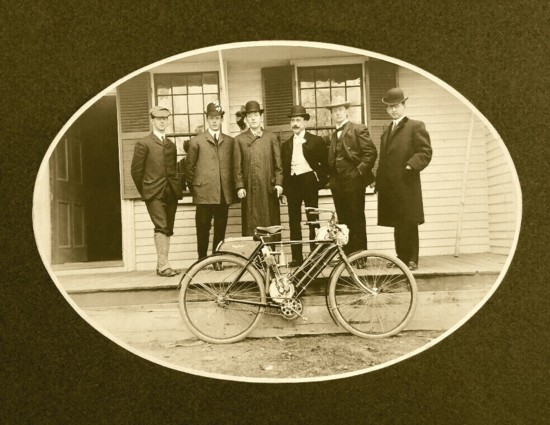
On the evenings of the 23rd and 24th of November, 1899, Frisbee proudly displayed the first Hedstrom “infernal machine” in the window of his bicycle shop on Main street in Middletown for the public’s viewing pleasure. Those who took the time to check it out were not disappointed.
The new machine was shipped to Miller on November 27th 1899, for its first trial run on the Berkley Oval in New York. The machine was introduced to the racing circuit on December 16, 1899, at Madison Square Garden in the closing race of the indoor racing season, which featured Harry Elkes going against the French champion Edouard Taylore in a hotly competitive one-hour pursuit race for the International Championship.
The new Hedstrom machine was one of three motor tandems that paced Elkes in front of six thousand spectators. Elkes crushed Taylore, beating him by twenty-six laps or two and a half miles. Sports commentators said that Taylore’s motor pacers, managed by Fournier, offered no competition. The Hedstrom machine provided to Miller would become known as the “Royal Blue Express.”
Hedstrom undoubtedly found in Frisbee his match.
Frisbee, an inventor with mechanical aptitude of his own, was granted patent no. 656,539 on December 19, 1899, with the title, “Multiple Cylinder Gas Engine.” His motor was designed specifically “for bicycles and other light vehicles.”
The partnership between Hedstrom and Frisbee dissolved in January 1900, soon after the work on the first prototype ended. Frisbee went on to pursue his interests in marine engines and automobiles.
No one is sure where that first motor came from. Many have said it was very similar to the French made DeDion motor. Hedstrom had no foundry to work from so it is probable that the castings were provided by some unknown machine shop making their own version of a DeDion, or another possibility was that Hedstrom made the pattern himself and used the foundry at Warwick Motorcycle in Connecticut. Presumably Hedstrom refined the design over the original DeDion motor because his machine was notably superior to anything else available. Most likely it was just a modified DeDion as Hedstrom would soon buy more and stronger DeDion motors.
During an event at Madison Garden in New York City in January 1900, another former super star bicycle racer turning business man witnessed Hedstrom’s “Royal Blue Express” motorized tandem and was so impressed that he ordered one from Hedstrom.
Hedstrom continued working on his own motorized pacers fitted with his modified DeDion “Typhoon” motors. Hedstrom’s tandem number 2 was built in May 1900, with a 3.25 hp DeDion engine. The number 3 followed with a 5 hp DeDion motor. Simultaneously Hedstrom built his custom racing bicycles. Several of the motor tandems were sold to racers in the spring, and he had numerous requests for more.
Now with a healed shoulder, he stopped producing tandems and went back to racing as he had many commitments for the season with his team. Henshaw and Hedstrom were close friends, raced together and worked together. According to the record, the team owned two motor-powered tandems. Henshaw also raced with Fournier.
Nothing is known about the interactions between Hendee and Hedstrom during the racing season of 1900 but the two would soon enter into a history making partnership. But first more about George M. Hendee.
George Mallory Hendee:
Unfortunately, Hendee’s first name mentioned in many descriptions of Indian motor bicycles and motorcycles and the history of Indian is wrongly stated as “Oliver” instead of “George M.,” even by renowned establishments as Bonhams and MECUM Auctions, who should know better. Google will find over 4,500 hits with Oliver Hendee as partner of Hedstrom instead of George M. Hendee.
George M. Hendee (October 2, 1866 — June 13, 1943) was a very successful bicycle racer in his own right.
Hendee took up bicycle racing at age 16. He won the United States National Amateur High Wheel Championship every year from 1882 till 1886, setting a new world record over a dirt half-mile track of 2 minutes 27.4 seconds in 1886, which he held until 1892. Hendee was America’s first national cycling champion, winning 302 of the 309 races he entered and dedicating himself to racing and traveling to bicycling events. Bicycle racing became the most popular sport in the USA as the 19th century ended.
As Hedstrom, Hendee was also a successful bicycle racers which turned entrepreneur once he was past his athletic prime.
Most of the following account is based on the research and work of Ken Aiken, and published on The Vintagent website by Paul D’Orleans in three parts. It is by far the best account of the History of Indian I could find on the web. To read part I, click here; and, part II, click here; and, part III, click here!
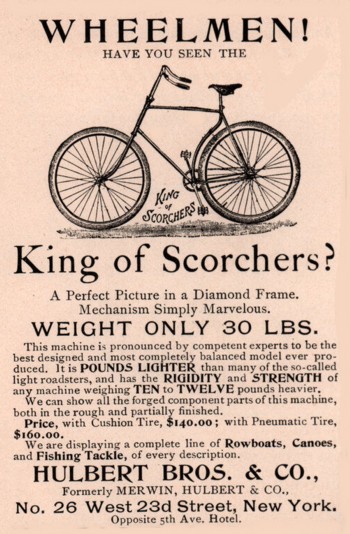
Starting in January 1892, Hendee was managing the bicycle floor of the Hulbert Brothers store in New York City that sold King and Queen of Scorchers bicycles, see 1892 advertising on the left.
Just half a year later, he was offered the presidency of Warwick Cycles, but declined. In March 1893, Hendee became the New England agent for Rudge, Sylph, and Overland bicycles. He was still participating at the Springfield track as a judge and timer at the time.
In mid January of 1894 he sailed for England where he apparently made arrangements with suppliers of bicycle components. By December he had completed his models of the Silver King and announced an installment program that was to begin on January 1, 1895.
The first Silver King bicycle ad appeared in the January 4 issue of The Wheel. The Silver King bicycles to order were made at his shop in the Stacy building at 41-43 Taylor Street in Springfield, Massachusetts, using parts he imported from England. (At this time the Duryea automobile was being produced on the third floor of this building.)
On November 23, 1895, Hendee sold half interest to Eddie Nelson, who had been working with him for the past year, and the business acquired a $10,000 loan from Nelson’s father-in-law, Mr. Holbrook. Hendee & Nelson Manufacturing Co. was formed and the shop expanded to include 10,000 sq. ft. on two floors at 478 Main Street.
By the mid 1890’s, wooden board-track velodromes across the country hosted events at which thousands of spectators attended. Bicyclists also were taking touring trips and railways advertised popular destinations for cycling tourists. L.A.W. had over 100,000 members and actively lobbied Congress to support the Good Roads Movement.
In March 1897 a legal notice was published in The Wheel: “The Hendee & Nelson Mfg. Co., 478 Main St, Springfield, Mass., will hereafter be known as E. H. Nelson & Co. Mr. Hendee will devote more of his time to the factory on Taylor Street.”
On August 18, an attachment was levied by the court and all of the company’s assets were seized; the following month Hendee & Nelson Mfg. filed for insolvency. Like so many other bicycle companies, it failed because the market was glutted with over-produced inventory and cutthroat competition had slashed retail prices to the bone. However, George Hendee had an extensive family, business and industry network. He acquired the tools and inventory of his former company at auction, raised $5,000, and incorporated the Hendee Manufacturing Company in January 1898. His new line of bicycles was called Indian. Hendee sponsored bicycle races through out the North East.
As mentioned before, Hendee was impressed by the “Royal Blue Express,” and its reliability during the event at Madison Garden in New York City in January 1900, and suggested to Hedstrom he design a motor-bicycle to be mass produced by Hendee Mfg. Co,. Hendee and Hedstrom would soon enter into a partnership.
Hendee Manufacturing Co., Springfield, Massachusetts:
Hendee and Hedstrom signed a partnership agreement in January 1901, and Hedstrom became the chief engineer and designer of Hendee Mfg. Co.
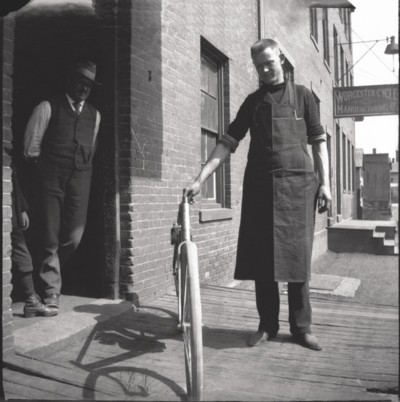 The first prototype they would sell later under the brand name Indian was still built by Hedstrom at the old Worcester Cycle Manufacturing Company in Middletown, Connecticut. The photograph on the right shows Hedstrom with his first prototype; is the straight–on shot deliberate or a sign of a photographer lacking skills? Is Hedstrom trying to hide his design? We shall never know — only the cast shadow of his prototype shows the outline of the construction.
The first prototype they would sell later under the brand name Indian was still built by Hedstrom at the old Worcester Cycle Manufacturing Company in Middletown, Connecticut. The photograph on the right shows Hedstrom with his first prototype; is the straight–on shot deliberate or a sign of a photographer lacking skills? Is Hedstrom trying to hide his design? We shall never know — only the cast shadow of his prototype shows the outline of the construction.
Picture courtesy of the Lyman and Merrie Wood Museum of Springfield History.
The first public demonstration of Hedstrom’s prototype was held on Cross Street in Springfield, Massachusetts at 12:00 noon on Saturday June 1, 1901.
The Hendee Mfg. Co., needed help to mass produce Hedstrom’s engine and the Aurora Machine and Tool Co. seemed to be the right partner.
Aurora started as a machine shop in 1886; by 1903 they had a large line of parts including ten different rear hubs, five different front hubs, racing hubs, spokes, nipples, handlebars, special spoke washers to be used with wooden rims and a large number of patents were listed.
Aurora apparently provided Hendee already with castings for his Silver King and Silver Queen bicycles.
Hendee’s Mfg. Co., in Springfield, had no facilities to reproduce Hedstrom’s designs, so they sent one of the motors to Aurora, to see if they could produce and supply Hendee Mfg. with engine castings after Hedstrom's design.
Machinists at the Aurora factory noticed the Hedstrom design overheated very quickly and improved the castings by adding additional cylinder wall strength and fins to the castings to improve air cooling. The changes were approved by Hendee and Hedstrom and the two companies entered into a production agreement which made Aurora the exclusive engine supplier for all Indians built from 1902-1907. Part of the production agreement allowed Aurora to sell these same engines to other motorcycle manufacturers, as long as Aurora was not in direct competition with Indian by building their own cycles, and royalties from sales of the engine to other companies were paid to Hendee Mfg.
Aurora quickly formed the Thor Motocycle and Bicycle Company in 1903, allowing Aurora to sell its engines to just about any other brand name being produced at that time, including Torpedo, Chicago, Pope (Rambler), Reading Standard and several others. After several months’ work, the Aurora Company produced a new motor of Hedstrom’s design. These motors differed from the prototype most notably in the use of three cylinder studs instead of the four found on the DeDion engine. Also some ribs were added to strengthen the engine case as mentioned before.
Hendee Mfg. Co., produced 137 Indian motorcycles in 1902. Hendee was previously in the bicycle manufacturing business and so it is assumed that Hendee Mfg. Co., brazed together their own frames, manufactured their own fenders and tanks, and did their own painting and assembly.
It is known that Hedstrom had patents for a “Fuel or other reservoir,” patent no. 707,922, issued on August 26, 1902; the “Chain Adjuster,” patent no. 707,923, issued the same day, August 26, 1902; “Valve For Internal Combustion Engines” patent no. 712,929, issued November 4, 1902; notably his patent for “Controlling Mechanism For Internal Combustion Engines,” patent no. 727,944, issued May, 12, 1903 (see pictures above for this patent and also picture 14 and 15 showing the two extreme positions of the Controlling Mechanism); “Carburetor,” patent no. 730-649, issued June 9, 1903; and, “Muffler For Internal Combustion Engines,” patent no. 712,791,issued July 2, 1907.
It is unknown if Aurora made or sold any motors in 1902 other than the 137 which went to Hendee for to first Indians. It is possible that that was all they could produce, as a reference found in the Indian archives mentions how shipments were often unreliable and sporadic.
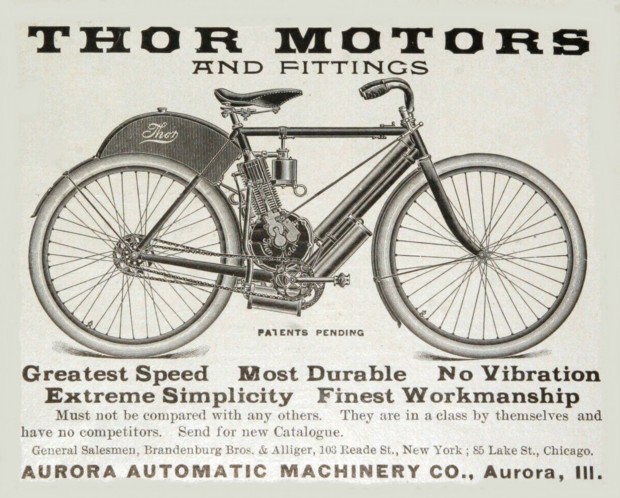
In 1903 Aurora founded the Thor Motorcycle and Bicycle Company. Or at least they produced a catalogue showing Thor motorcycle parts and components. In their catalogue every part needed to produce a motorcycle was listed for sale. A picture carefully worded as a “motorcycle assembled from Thor components” was shown.
The picture on the left shows an advertisement published in 1903 by Aurora Automatic Machinery Co., Aurora, Ill.
Interesting that they might have their own tank decal if they were only selling components for other companies! No frame was offered for sale but all of the forgings could be purchased to assemble your own.
Hedstrom was not the only one with ideas to improve motor-bicycles.
Nelson S. Hopkins (1870-1943) received patent no. 543,094, issued on July 23, 1894, for his “IMPROVEMENT IN MOTORS FOR BICYCLES.”
Edward J Pennington (1858-1911) was the holder of patent no. 574,262, issued on December 29, 1896, with the title “MOTOR VEHICLE” showing a motorized bicycle.
Robert M. Keating was issued patent no. 675,387, on June 4, 1901, with the title, “Motor-Bicycle.” Keating’s idea was to have the motor being part of the bicycle frame to reduce weight,
“I prefer to make the casing ‘g’ a connecting-link between the lower bars ‘f’ and the crank-hanger bracket, thus suspending the motor in the most desirable position and giving the frame the requisite strength, lightness, and rigidity.”
Hedstrom’s design with the motor being the substitute of the seat-post was found to infringe the Keating patent. Keating not only sued Indian, he also sued successfully Harley Davidson.
George W. Manson followed with his patent number 678,963, issued on July 23, 1901, with the title, “MOTOR CYCLE.” Click on any patent number to see the patent papers!
This list is by no means complete, it just showed that many had an obsession about inventing the successful motor bicycle.
However, the partnership between Hedstrom and Hendee proved to be most successful and Hedstrom’s motor victorious. It is estimated that less than a dozen Hedstrom motors of the first design survived making the motor offered here exceedingly rare and important.
Hendee participated with one of the early motor bicycles powered with the Hedstrom engine at the first American endurance race from Boston to New York in 1902, and also the first long-distance track race in 1903, winning both races.
The Indian motor bicycle used a chain to the rear wheel rather than the then common practice of using belts. A multi-cell dry battery mounted below the front frame tube provided spark energy for up to 1,000 miles, while the one-pint oil tank provided total-loss lubrication for up to 200 miles. The patented hump-shaped fuel and oil tank mounted behind the seat earned it the “Camelback” name and remained a familiar Indian design feature, although from 1906 it held only fuel. Top speed of the production model was around 30mph. An other source claims that the advertised top speed was up to 45mph.
Hendee, Hedstrom, and their Indian Motocycle Co. began to reshape the landscape of American transportation and motorsport. The motorcycle, pushed ever forward in its evolution by Hedstrom and Hendee, harnessed the swell of enthusiasm generated in the cycling industry at the turn of the 20th century, and channeled it into a brand new frontier, creating a new era of personal transport, utility, and sport. It was the beginning of a revolution in manufacturing, innovation, and competition. The motorcycle represented the bleeding edge of technology in America, and Hedstrom’s Indian was at the forefront, leading the way and becoming one of the most significant and iconic motorcycle brands in history. By 1912, Hendee Manufacturing was the world’s largest motorcycle manufacturer. In 1913, the company’s production peaked at 32,000 units.
The contract with Aurora would end on March 5, 1907, after which date Hendee Mfg. Co., manufactured all their engines in-house.
By 1912, Hendee Manufacturing was the world’s largest motorcycle manufacturer. In 1913, the company’s production peaked at 32,000 units. In 1915, Hendee resigned as general manager but remained as president. In 1916, at the age of 49, Hendee retired from Hendee Manufacturing after a disagreement with the board of directors over the direction of the organization. In his retirement, he bred Guernsey cattle and White leghorn chickens on his 500-acre Hilltop Farm in Suffield, Connecticut. He sold his estate in 1940 and moved to a smaller home in Suffield where he died in 1943 at the age of 76.
What followed was half a century of unparalleled growth in motorcycle production and innovation, and foundational leadership in curating a true American riding culture.
The Indian Motocycle Company:
In 1923, the Hendee Manufacturing Company changed its name to The Indian Motocycle Company — no “r” in “motocycle.” Over its early years of existence, the company displayed extraordinary resilience as its trailblazing success in innovation and on the racetrack continued despite the advent of the Great Depression and two world wars. In fact, not only did the brand survive these tumultuous times, but its considerable contribution to the war effort during WWI and WWII provided essential vehicles to both the American and French troops on the ground.
Literature:
(Click on any title to see the online version of the book or publication if there is one.)
Inventory Number 09348;
Sold!
